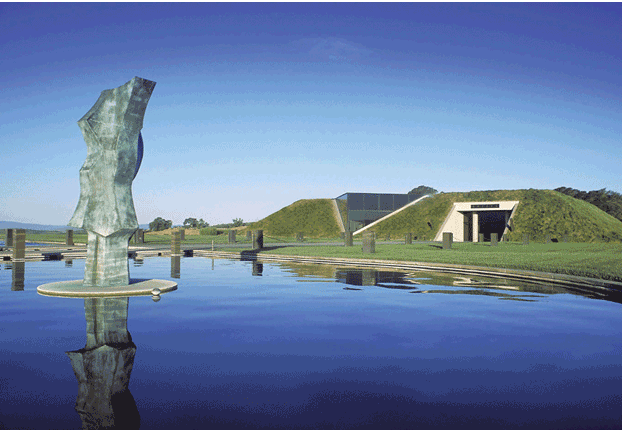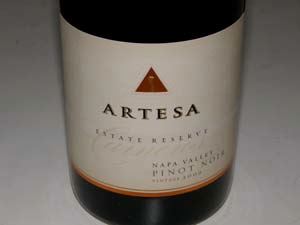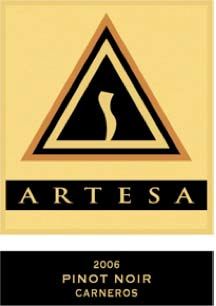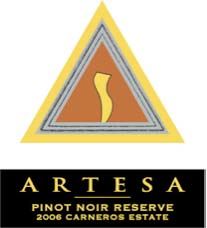Artesa Vineyards & Winery
| Owner(s) | Codorníu Group |
| Web site | www.artesawinery.com |
| Link to this site |

Artesa (ahr TESS uh) translates as craftsman in Catalan, the language of Barcelona, Spain and of Codorníu, the winery’s owner. The Codorníu family has been making wine since the mid-sixteenth century in the Penedès region of Spain, west of Barcelona. In 1872, the winery produced the world’s first méthode champenoise wines outside of Champagne, France. The new sparkling wine was called “cava” after the caves or aging cellars.
In 1991, the owners of the Codorníu Group, the Raventós family, opened the Codorníu Napa sparkling wine facility on a 350-acre estate overlooking the Carneros side of the Napa Valley. Sparkling wine demand lagged in California thereafter and despite the $30 million initial investment, the decision was made to completely transform the sparkling wine production winery into a still wine producing facility able to handle numerous small lots of grapes, juice and wine individually. In addition, vineyard acquisitions were obtained in some of the best growing areas of Napa. Well-known winemaker Don Van Staaveren was brought in. The new winery and vineyard additions amounted to another $20 million investment. The Artesa Winery officially opened in 1997 with the release of the winery’s first still wines.
In 1995, Artesa hired Dave Dobson as vice president for production and winemaking. He had previously been in charge of the premium wines at Kendall-Jackson and most recently brought Rutherford Hill Merlot to much acclaim. Dobson instituted a number of improvements in the winery including new sorting tables and a technique known as "pump under" which saves labor and tends to soften wines. In 2009, Mark Beringer replaced Dobson. Beringer is a fifth generation winemaker from Napa Valley, the great, great grandson of Beringer co-founder, Jacob Beringer. He achieved winemaking notoriety at Duckhorn Vineyards before joining Artesa. In 2015, Beringer left to work at Beringer Vineyards and was replaced by Ana Diego-Draper, a Portuguese native. She had joined Artesa in 2013 after eight years at Ruthervord Hill Winery and is the first woman to hold the top winemaking position at Artesa.
Artesa Winery produces multiple still varieties sourced from its 330 acres of vineyards in Carneros, Foss Valley Vineyards in the Atlas Peak AVA of Napa and the Alexander Valley AVA of Sonoma. The 150 acres of Carneros vineyards are devoted primarily to Chardonnay and Pinot Noir. Artesa produces both a Classic Tier and Reserve Tier of Pinot Noir along with Limited Release Wines as vintages dictate. Codorníu sparkling wines are also available and distinguished (1,000 cases). Total production is 60,000 to 80,000 cases of still wine per year.
The wines are available for sale in the winery’s visitor center, on the website and through retail distribution channels. Four wine tasting experiences are offered at Artesa Winery including a private tasting with the winery’s wine educator, an intimate wine and cheese tasting, a unique vineyard tour and tasting, and an exclusive barrel room tasting of the winery’s best, very limited wines. Call the winery at 888-679-WINE for availability and appointments. The tasting room is open daily from 10:00 to 5:00. Voted best tasting room in Napa by readers of The Bohemian newspaper. Artesa wines can also be sampled at Cornerstone Place in the town of Sonoma.
Articles About Artesa Vineyards & Winery
Reviewed Wines

2011 Artesa Carneros Chardonnay
13.8% alc., pH 3.55, TA 0.63, 2,500 cases, $20. Aged 50% in
30% new French oak and 50% in stainless steel. 20% estate fruit and 80% neighboring vineyards.
30% MLF. A portion of the wine was lees stirred for 5 months. Bottled after 6 months of aging.
·
Light
yellow color and clear in the glass. Fresh aromas of apple, citrus and butter. Crisp and clean,
refreshing and uplifting, with flavors of citrus, pear, roasted nuts, clove spice and a touch of tropical
fruits. A pleasant, easy to like wine, offering excellent value. An Estate Reserve is also offered at
$35. Good.
Reviewed January 19, 2013
ARTICLE »

2009 Artesa Estate Reserve Carneros Pinot Noir
14.3% alc., pH 3.47, TA
0.57, 3,000 cases, $40. 100% destemmed. Aged 10 months in 40% new French
oak barrels.
·
Moderately dark reddish-purple color in the glass. Bright aromas of
fresh, very ripe plum and black cherry with hints of musk and grilled beef. Mid
weight flavors of dark berries, black cherries and black plum with a hint of tar
and earth. Very polished with good structural bones. A bit exotic, but very
Carneros in character. Very good.
Reviewed January 19, 2013
ARTICLE »

2007 Artesa Carneros Pinot Noir
13.9% alc., 22,000 cases, $25. Aged 10 months in French
oak.
·
The is reminiscent of cherries kissed by good dark chocolate. Moderately light and
smooth in texture with fine-grained tannins and admirable acidity. A very good entry Pinot Noir
and daily drinker. Fantastic quality considering the extremely large case production.
Reviewed February 12, 2009
ARTICLE »

2007 Artesa Winery Limited Release Carneros Pinot Noir
889 cases, $50. Winemaker
Dave Dobson crafted this wine but he has recently departed and has been replaced by Mark
Beringer, formerly of Duckhorn. This wine is composed of the most outstanding barrels in the
cellar and generally needs time to shed its tannins.
·
Deep dark reddish-purple color.
Appealing aromas of plums, currents and spice. Plush core of earth-kissed dark fruits and
sassafras with exotic spices. Less tannic than the 2006 version of this wine with a little more
lively acidity.
Reviewed April 18, 2009
ARTICLE »
2006 Block 91 D Carneros Pinot Noir
14.7% alc.,100-120 cases, price TBA.
·
A highly structured wine with
substantial tannins. Shy on the nose but powerful in the mouth with deep, rich darker fruits complimented by
smoky oak and an Oreo cookie taste. Still closed and brooding, this one will require at least 1 to 2 years in the
cellar but will always be a muscular wine.
Reviewed February 12, 2009
ARTICLE »
2006 Artesa Carneros Pinot Noir
13.9% alc., $25.
·
A light and feminine Pinot Noir showing delicate cherry
and strawberry aromas and flavors enhanced with spice and savory herbs. A simple but pleasing wine with
commendable balance. Perfectly fine with grilled salmon.
Reviewed February 12, 2009
ARTICLE »

2006 Artesa Estate Reserve Carneros Pinot Noir
14.35 alc., 3,500 cases, $40. Aged in 50%
new French oak.
·
A step up in aromatic intensity from the regular Carneros bottling. Aromas of
red berries and cherries touched by herbs. Friendly in the mouth with good red fruit intensity, an
appealing spiciness, and a silk and satin texture. The finish has noticeable persistence.
Reviewed February 12, 2009
ARTICLE »
2006 Artesa Limited Release Carneros Pinot Noir
14.5% alc., 800 cases, $50. Aged 10 months in French
oak barrels. Composed of the most outstanding barrels in the cellar.
·
Darkest in color of all the wines tasted.
A pinotypical nose of dark berry and cherry fruit with a sidecar of oak. Tasty blackberry and black raspberry
fruit with an appealing earthiness and a hint of citrus peel tang on the persistent aromatic finish. A substantial
wine that is still reticent and needs time to shed some of its soft, dry tannins. A year or two in the bottle will
benefit this wine. That said, I drank this wine at the winery with pan roasted wild sea bass with Meyer lemon
buerre blanc, quinoa pilaf and Sicilian spinach and the result was spectacular. The roasted fish tamed the
tannins of the wine and the grippy acidity of the wine matched perfectly with the buerre blanc.
Reviewed February 12, 2009
ARTICLE »

2006 Artesa Haire Vineyard Carneros Pinot Noir
14.7% alc., 100-120 cases, $80. This
wine is sourced from a unique site that formerly provided grapes for Etude’s Heirloom bottling. The
clones are Swan and Martini. Rapidly draining compressed ash soils characterize this vineyard in
contrast to the uplifted clays of varying depths over rock in the vineyards close to the winery.
·
Evocative scents of Bing cherry, herbs, cola, toasty oak and a faint whiff of alcohol. This wine has a
silky, comforting quality that is quite sexy. The tasty cassis and cherry core has subtle notes of
citrus, Provencal herbs and oak in the background. The tannins are well tamed and the overall
impression is one of assertive elegance reflective of winemaking excellence.
Reviewed February 12, 2009
ARTICLE »
2011 Artesa Carneros Chardonnay
13.8% alc., pH 3.55, TA 0.63, 2,500 cases, $20. Aged 50% in 30% new French oak and 50% in stainless steel. 20% estate fruit and 80% neighboring vineyards. 30% MLF. A portion of the wine was lees stirred for 5 months. Bottled after 6 months of aging. · Light yellow color and clear in the glass. Fresh aromas of apple, citrus and butter. Crisp and clean, refreshing and uplifting, with flavors of citrus, pear, roasted nuts, clove spice and a touch of tropical fruits. A pleasant, easy to like wine, offering excellent value. An Estate Reserve is also offered at $35. Good. Reviewed January 19, 2013 ARTICLE »

2009 Artesa Estate Reserve Carneros Pinot Noir
14.3% alc., pH 3.47, TA 0.57, 3,000 cases, $40. 100% destemmed. Aged 10 months in 40% new French oak barrels. · Moderately dark reddish-purple color in the glass. Bright aromas of fresh, very ripe plum and black cherry with hints of musk and grilled beef. Mid weight flavors of dark berries, black cherries and black plum with a hint of tar and earth. Very polished with good structural bones. A bit exotic, but very Carneros in character. Very good. Reviewed January 19, 2013 ARTICLE »

2007 Artesa Carneros Pinot Noir
13.9% alc., 22,000 cases, $25. Aged 10 months in French oak. · The is reminiscent of cherries kissed by good dark chocolate. Moderately light and smooth in texture with fine-grained tannins and admirable acidity. A very good entry Pinot Noir and daily drinker. Fantastic quality considering the extremely large case production. Reviewed February 12, 2009 ARTICLE »

2007 Artesa Winery Limited Release Carneros Pinot Noir
889 cases, $50. Winemaker Dave Dobson crafted this wine but he has recently departed and has been replaced by Mark Beringer, formerly of Duckhorn. This wine is composed of the most outstanding barrels in the cellar and generally needs time to shed its tannins. · Deep dark reddish-purple color. Appealing aromas of plums, currents and spice. Plush core of earth-kissed dark fruits and sassafras with exotic spices. Less tannic than the 2006 version of this wine with a little more lively acidity. Reviewed April 18, 2009 ARTICLE »
2006 Block 91 D Carneros Pinot Noir
14.7% alc.,100-120 cases, price TBA. · A highly structured wine with substantial tannins. Shy on the nose but powerful in the mouth with deep, rich darker fruits complimented by smoky oak and an Oreo cookie taste. Still closed and brooding, this one will require at least 1 to 2 years in the cellar but will always be a muscular wine. Reviewed February 12, 2009 ARTICLE »
2006 Artesa Carneros Pinot Noir
13.9% alc., $25. · A light and feminine Pinot Noir showing delicate cherry and strawberry aromas and flavors enhanced with spice and savory herbs. A simple but pleasing wine with commendable balance. Perfectly fine with grilled salmon. Reviewed February 12, 2009 ARTICLE »

2006 Artesa Estate Reserve Carneros Pinot Noir
14.35 alc., 3,500 cases, $40. Aged in 50% new French oak. · A step up in aromatic intensity from the regular Carneros bottling. Aromas of red berries and cherries touched by herbs. Friendly in the mouth with good red fruit intensity, an appealing spiciness, and a silk and satin texture. The finish has noticeable persistence. Reviewed February 12, 2009 ARTICLE »
2006 Artesa Limited Release Carneros Pinot Noir
14.5% alc., 800 cases, $50. Aged 10 months in French oak barrels. Composed of the most outstanding barrels in the cellar. · Darkest in color of all the wines tasted. A pinotypical nose of dark berry and cherry fruit with a sidecar of oak. Tasty blackberry and black raspberry fruit with an appealing earthiness and a hint of citrus peel tang on the persistent aromatic finish. A substantial wine that is still reticent and needs time to shed some of its soft, dry tannins. A year or two in the bottle will benefit this wine. That said, I drank this wine at the winery with pan roasted wild sea bass with Meyer lemon buerre blanc, quinoa pilaf and Sicilian spinach and the result was spectacular. The roasted fish tamed the tannins of the wine and the grippy acidity of the wine matched perfectly with the buerre blanc. Reviewed February 12, 2009 ARTICLE »
2006 Artesa Haire Vineyard Carneros Pinot Noir
14.7% alc., 100-120 cases, $80. This wine is sourced from a unique site that formerly provided grapes for Etude’s Heirloom bottling. The clones are Swan and Martini. Rapidly draining compressed ash soils characterize this vineyard in contrast to the uplifted clays of varying depths over rock in the vineyards close to the winery. · Evocative scents of Bing cherry, herbs, cola, toasty oak and a faint whiff of alcohol. This wine has a silky, comforting quality that is quite sexy. The tasty cassis and cherry core has subtle notes of citrus, Provencal herbs and oak in the background. The tannins are well tamed and the overall impression is one of assertive elegance reflective of winemaking excellence. Reviewed February 12, 2009 ARTICLE »

